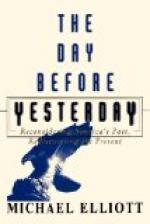with its black marble floor, its rose-coloured silk
walls where great silver sconces alternated with full-length
portraits of British sovereigns, its white “chunam”
columns and its gilt Italian furniture. “Chunam”
has been used in India from time immemorial for decorative
purposes. It is as white as snow and harder than
any stone, and is, I believe, made from calcined shells.
Let us suppose a Durbar held in this renovated throne-room
for the official reception of a native Indian Prince.
The particular occasion I have in mind was long after
Lord Lansdowne’s time, when a certain Rajah,
notoriously ill-disposed towards the British Raj,
had been given the strongest of hints that unless he
mended his ways, he might find another ruler placed
on the throne of his State. He was also recommended
to come to Calcutta and to pay his respects to the
Viceroy there, when, of course, he would be received
with the number of guns to which he was entitled.
The Indian Princes attach the utmost importance to
the number of guns they are given as a salute, a number
which varies from twenty-one in the case of the Nizam
of Hyderabad, who alone ranks as a Sovereign, to nine
for the smaller princes. Should the British Government
wish to mark its strong displeasure with any native
ruler, it sometimes does so by reducing the number
of guns of his salute, and correspondingly, to have
the number increased is a high honour. Sulkily
and unwillingly the Rajah of whom I am thinking journeyed
to Calcutta, and sulkily and unwillingly did he attend
the Durbar. On occasions such as these, visiting
native Princes are the guests of the Government of
India at Hastings House (Warren Hastings’ old
country house in the suburbs of Calcutta, specially
renovated and fitted up for the purpose), and the
Viceroy’s state carriages are sent to convey
them to Government House. Everything in the way
of ceremonial in India is done strictly by rule.
The precise number of steps the Viceroy will advance
to greet visiting Rajahs is all laid down in a little
book. The Nizam of Hyderabad is met by the Viceroy
with all his staff at the state entrance of Government
House, and he is accompanied through all the rooms,
both on his arrival and on his departure; but, as
I said before, the Nizam ranks as a Sovereign.
In the case of lesser lights the Viceroy advances anything
from three to twenty steps. These points may
appear very trivial to Europeans, but to Orientals
they assume great importance, and, after all, India
is a part of Asia. At right angles to the Calcutta
throne-room is the fine Marble Hall, with marble floor
and columns and an entirely gilt ceiling; empty except
for six colossal busts of Roman Emperors, which, together
with a number of splendid cut-glass chandeliers of
the best French Louis XV. period, and a full-length
portrait of Louis XV. himself, fell into our hands
through the fortunes of war at a time when our relations
with our present film ally, France, were possibly less
cordial than at present. For a Durbar a long




